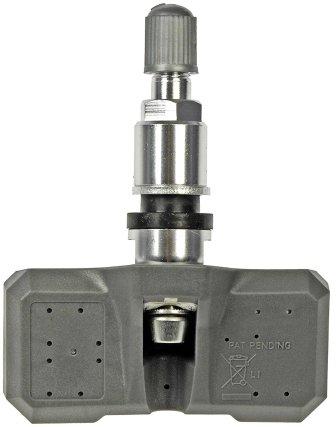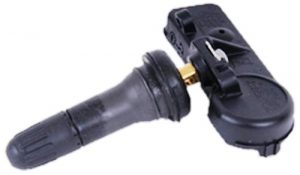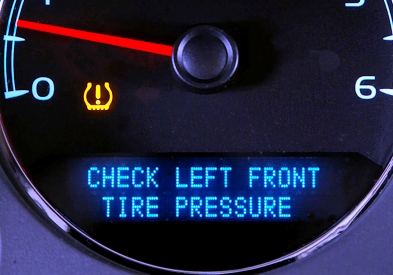Guide to Tire Pressure Warning Systems
The tire pressure warning system made the standard equipment list in early 2005. With that said, many car companies started deploying this technology in 1995. As this important safety equipment ages, they provide unique challenges for drivers and car owners. In this brief guide to tire pressure warning systems we’ll include interesting facts about both the newer and older systems.
In addition, we’ll talk about how a tire pressure monitor operates and the necessary maintenance to keep them operational going forward. Sidebar: many don’t realize that the wheel mounted sensors that actually report the tire pressure are powered by a small lithium-ion watch style battery. We’ll uncover how long these last and what happens when the juice runs out.
History of the Tire Pressure Warning System

In the United States, the Department of Transportation passed the TREAD act in the 2001 legislative session. This clever acronym stands for the Transportation Recall Enhancement Accountability and Documentation act. The details of the law force vehicle manufacturers to install a tire pressure warning device on all automobiles below a 10,000 pound gross vehicle weight by the year 2007.
Fortunately, manufacturers started installing the vital safety systems back in 1995. The convenience of knowing when a tire becomes low on air proved a valuable selling tool. For this reason additional car makers jumped on board to compete with automotive companies that already used the technology.
Porsche, the German the high performance automaker, deployed one of the first mass-produced and factory installed tire pressure warning systems. It came standard on the 1986 Porsche 959 turbo. In fact, many European car companies started including low pressure warning systems in the mid-1980s. The early systems deployed in 1995 proved troublesome despite the late participation of US automakers. They didn’t learn from a decade’s worth a mistakes from other major manufacturers.
Tire Pressure Monitoring System Operation

On modern tire pressure warning systems they transmit real-time data to a specialized module. The wheel mounted sensors sends this information via wireless communication. The technology is basically on the same level as a key-less entry remote fob. Nevertheless, some manufacturers attach the wheel pressure sensor at the center of each wheel. They accomplish this with a giant band that looks like a hose clamp.
Other car companies decided to start attaching the pressure sensor to the rubber tire stem. Both of these systems come with major disadvantages that we’ll discuss in the next section. What we need to understand about the tire pressure monitoring system is the communication between the module and the sensors.
On older automobiles this communication takes place intermittently at slow speeds. The new technology communicates real-time tire pressure to the warning module continuously. The reason this becomes important is how fast the monitoring system determines a tire is either low or refilled after a repair. This often relies on the year they manufactured the system.
Tire Pressure Warning the most Common Problem

Car makers, program a threshold limit into the control module on the assembly line. In other words, they have a designated pressure point that turns on the warning light. Some manufacturers shoot for a very low number in the 15 psi range. Other manufacturers up this number to notify the driver in the 20 to 25 psi range.
The higher the threshold number the greater the chances that the driver will become annoyed with frequent warnings of low tire pressure. Unfortunately, air is an unstable gas. Temperature changes affect internal pressures drastically. On a cold subfreezing morning the tire pressure can differ 5 to 8 psi from the normal operating temperature of a hot tire.
Therefore, the car owner comes out in the morning and finds a low tire pressure warning light illuminated. After driving an hour to work this light goes out. Why? Because the pressure increases inside the tire as it warms from friction. Manufacturers walk the line between caution and safety versus annoying the driver. A solution exists for this problem. The answer is to fill the tires with nitrogen gas. Let me use the same example from above. A nitrogen filled tire only fluctuates 1-2 psi instead of the 5 to 8 of an ambient air filled tire.
Tire Issues that Turn on the Pressure Warning Light

As we mentioned above, sometimes the light turns on a warning of low pressure when there’s actually nothing wrong with the tire. With that said, when the light pops on you could actually have a tire problem that needs correction. Leading the pack of common issues remains a puncture wound in the tire tread.
A screw or a nail can easily find its way into the tire and slowly leak off enough pressure to turn on the warning lamp. We wrote an excellent article here on certifiedmastertech.com covering how to properly repair a damaged tire. Nevertheless, although a nail in the tire becomes the most common issue other circumstances arise that turn on the warning light.
Some of the most popular cars ever built in this decade use tire stem mounted air pressure sensors. They power these devices with a lithium-ion battery. This power cell lasts about 10 years. As we keep cars on the road longer we’ll find it necessary to replace these sensors. Unfortunately, on most models the battery is not serviced separately. You can check in your vehicle specific auto repair manual to confirm this. With the cost of around $60 per tire stem and sensor combination, this adds up to a large repair bill.
However, another problem arises from tire replacement services. The technicians need to show extra care when they break the tire bead loose from the wheel. These fragile plastic and rubber pressure sensor devices damage easily. What if the tire pressure warning light comes on after tire service? You must return to that facility immediately. In my opinion repair of the tire monitor in that scenario becomes a no charge situation.


